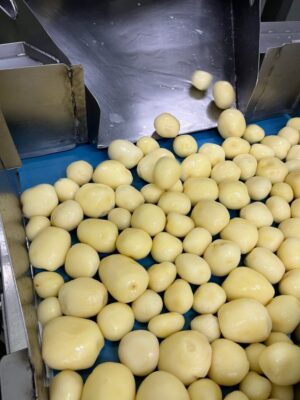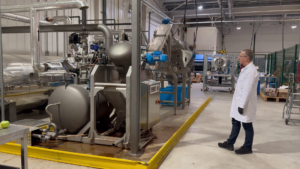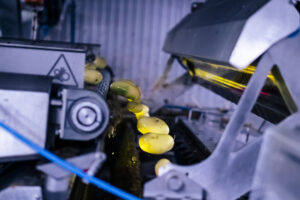Steam peeling can reduce food waste, save energy
When peeling vegetables, many processing lines waste huge amounts of food ― and potential revenue. With modern peeling machines, this can be prevented while also reducing energy costs and water consumption.

Eamonn Cullen, marketing manager, peeling at TOMRA Food, explains how.
Food waste is financial waste, yet when processing lines peel vegetables, they often let huge amounts of raw material get thrown away. Food losses can be as high as 30% during mechanical peeling and 20% with low-tech steam peelers — and much of this lost revenue is preventable.
Rather than accepting this, vegetable processors can do something about it. Instead of sticking with outdated peeling machines or buying low-cost peelers with low efficiency, processors can reduce waste significantly by investing in more effective technologies. There are several compelling reasons to do this.
Modernized equipment
Many vegetable processing lines around the world are now 20 to 30 years old. They need modernizing, and this is the perfect opportunity to install machinery that’s more reliable and more efficient, including the best modern steam peelers.
Why modernize?
For safety ― operator and electrical safety ― with mechanical touchpoints protected. Vessels are exposed, so steam comes out and workers can get burned. The new steam peelers are fully automated and fully enclosed, around 220° C, which is 400+° F, so steam is at very hot temperatures and high pressure.
Another reason to modernize is hygiene. Most older plants didn’t have a focus on hygiene. All bacteria traps can be removed, so machinery is now up to date.
A third is automation: Emergency stops and fail safes are now incorporated into machinery. There is no more turning knobs by hand.
Another reason is that vegetable processing has changed over the years. More big businesses are now participating in the industry, and more are responding to the growing demand for peeled vegetables as an ingredient for prepared meals. This has led to lines increasing both the volume and the variety of the vegetables they handle. Whereas low- volume processing lines might operate only for a few months each year during the harvesting season of one type of vegetable, medium- and large-volume lines handle different kinds of vegetables with harvesting seasons at different times of the year. Waste that’s tolerated for a few months annually is intolerable when seen every day of the year.
One of the benefits of steam peeling is that the product retains its shape. Steam peeling treats water below the product and heats it. Also, paring will grind off some of the product.
North America was the first place to introduce high pressure steam peeling. Heinz Foods was one of the first processing plants. It decided against working with chemical peeling systems.
Huge advances have been made in peeling technologies. It remains true that mechanical peelers are wasteful and lower-tech steam peelers are also inefficient — but the more sophisticated steam peelers are something else. Technical innovations have greatly improved operating speed, peeling efficiency, controllability, energy use, and safety. Peeling quality is higher, uniformity greater, food waste usually lower than 10% and sometimes as low as 6.5%. On some lines this prevents the loss of an estimated 1,000 kilograms, or 2,204 pounds, of vegetable material every hour. That’s an estimated saving of €200,000, or $241,176, per year.
Taking action to reduce food waste demonstrates a commitment to sustainability. This matters both for economic and environmental reasons. Because the global population is growing so fast, food production will need to increase by 70% by 2050, according to the United Nations’ Food and Agriculture Organization. Yet the food sector already accounts for about 30% of the world’s total energy consumption and 22% of greenhouse gas emissions. To make matters worse, some 14% of food produced is lost between harvest and retail. And it’s not only the UN that cares about these things: food buyers do, too. Consumers increasingly expect food businesses to adopt sustainable practices, and food retailers expect the same from their suppliers.
Peeler versatility presents big advantage
TOMRA Food, known for its optical sorting and grading technologies, has ongoing investment in research and development, a deep-rooted culture of innovation and decades of experience working closely with processors to truly understand their operational challenges.

More than 500 TOMRA steam peelers are currently in operation around the world. Approximately two-thirds of these process potatoes and one-third process other vegetables — mostly carrots, but also beetroot, butternut squash, kohlrabi, parsnip, pumpkin and root celery. Some processors peel all these products in the same factory, sometimes on the same line. This is made possible by the versatility of TOMRA’s sorters and steam-peelers; by these machines being designed to be easy to clean, which helps prevent cross-contamination; and by the machine controls having menus which allow operators to switch easily from one type or size of vegetable to another.
Machine versatility is also important on lines that process only one type of vegetable because the crops coming out of the ground can be so variable. It’s not easy achieving consistent product quality when vegetables are irregular in size, shape, and quality. This challenge has become tougher in recent years because of climate change: once-predictable seasonal temperatures and rainfall are now erratic, affecting crops. This makes it even more important to have a peeler with processing flexibility — an advantage that must be designed into the peeler’s batch weighing module, pressure vessel, steam exhaust system and control program.
Peeler performance depends on design
In addition to versatility, another key for unlocking greater yields is peeler performance. Best performance is attained by peeling at high steam pressure for a short time. Low-cost, low-tech steam peelers simply can’t do this: steam can only be delivered to their thin-walled vessels at low pressure and the vegetables have to be steamed for as long as 40 to 100 seconds. This wastes more than twice as much raw material as the best high-tech steam peelers and consumes far more energy and water.
TOMRA offers the Orbit, the Odyssey and the Eco steam peeler. Since 2020, each of these machines has been equipped with fully automated control programs, making it easy to switch between different types and sizes of vegetables, optimizing process efficiency and yield.
The Orbit is popular for its versatility and because it straddles the middle ground between the entry-level Odyssey and the high-performance Eco steam peeler.
The Odyssey is for users who want to peel efficiently but have a smaller budget for investing in equipment. This machine’s longer pressure vessel is intended primarily for larger vegetables.
The Eco, launched in 2012, introduced sophisticated automation software to optimize steam usage and achieve similar throughput capacities with a smaller vessel. It is mostly used for peeling potatoes, but it’s also well-suited to some types of vegetables, such as carrots and red beets.

Post-peeling products
TOMRA also supplies and integrates post-peeling equipment. To take care of dry peel separation and washing, the company has developed various products for large and small vegetables, and for low and high capacities.
The most used, TOMRA’s 8/30 Brusher, has unique features for dry peel separation, wet peel separation, washing, quick and easy cleaning to remove potential sources of cross-contamination, and easy changeover to different vegetables.
The brush will remove skin on potato crevices at a rate of 400-500 rpm. Peel waste is thrown off and users do not need to use water ― a big plus.
The TOMRA Barrel Washer handles vegetables more gently than other machines, which has made product damage during washing a thing of the past.
This post-peeling equipment also improves sustainability. When wet- washing, water filtration (with a reusable rotary screen filter) reduces water consumption; with dry separation, water consumption at this stage of the process is eliminated.
Another part of the process is sorting. It is necessary to get foreign matter out of any produce coming in. Sorting is a three- to five-step process in a processing facility. Sorters get out defects, bad pieces, etc. and users are left with highest quality pieces. After all, a sorter “sees” products better than humans do.







